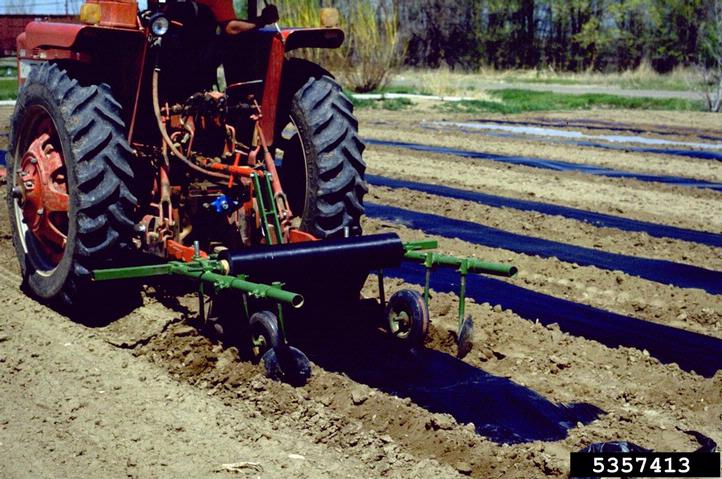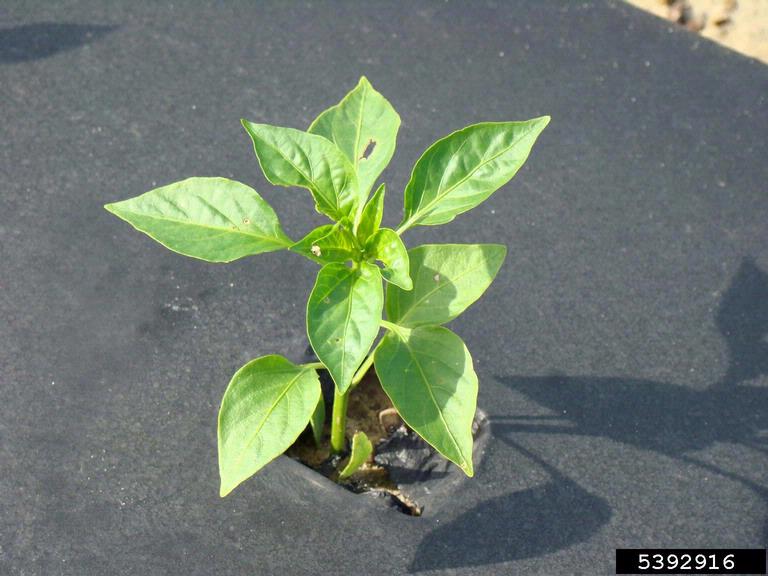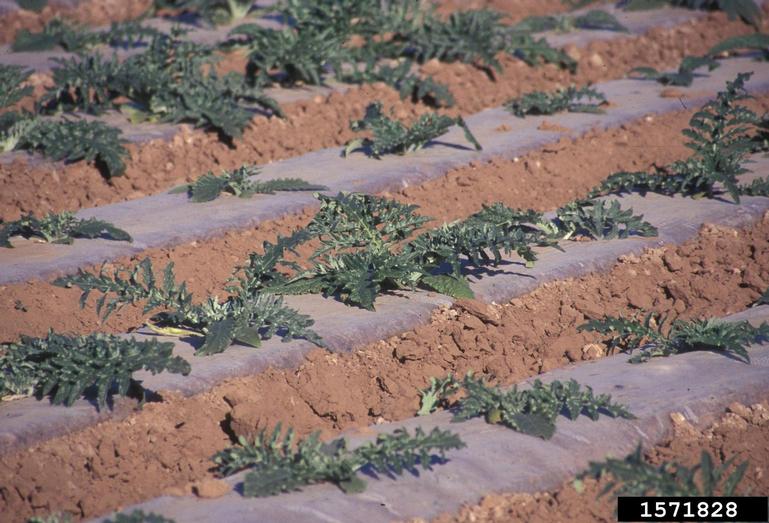 Using Plastic Mulches - March 25, 2015 Jeff Schalau, Agent, Agriculture & Natural Resources University of Arizona Cooperative Extension, Yavapai County Mulch is material applied to the soil surface to prevent weed growth, protect the soil from erosion, and reduce evaporation from the soil surface. Mulches are often organic material such as bark, sawdust, wood chips, grass clippings, straw, cardboard, newspaper, pine needles, or deciduous tree leaves. Inorganic mulches include plastics, landscape fabric, gravels, recycled tires, and other materials that are non-living and slow to decompose. Older landscapes often have heavy black plastic mulch underlying gravel or bark. This is fairly effective against weeds, but may not be so desirable for the roots of plants or the environment. When thick plastic mulch is used in large landscape areas, plants roots can be deprived of oxygen and precipitation is prevented from infiltrating into the soil. So, it is best to avoid using plastic mulches in decorative landscapes. My recommendation is to use desirable, drought adapted plants to displace and compete with weeds and recycled waste wood chips to mulch in decorative landscapes. Wood chips are often available from utility companies, landscape contractors, and at waste transfer stations. Plastic mulches do have other beneficial uses. Thin plastic mulches are often used in vegetable crops for a single season. Drip irrigation systems are placed prior to the installation of plastic mulch. Tractors can be fitted with specialized equipment that lays the mulch and covers the edges with soil holding it in place. Holes are punched in the mulch to plant young transplants or sow seed for individual plants. Vegetable crops which have been most successful when planted in these plastic mulches are muskmelons, tomatoes, peppers, cucumbers, squash, eggplant, watermelons, and okra. Cut flowers and strawberries are also commonly grown using plastic mulch. This practice has acquired the name “plasticulture”. Early research focused on the use of colored plastic mulch and the impact that differently colored mulches had on soil/air temperature, moisture retention, and vegetable yield. Today, three main colors: black, clear, and white are used in commercial vegetable production. White plastic mulch has been replaced largely by a co-extruded white-on-black which decreases light transmission and subsequent weed growth. The color of the plastic mulch largely determines its energy-radiating behavior and its influence on the microclimate around a vegetable plant. The color also affects the surface temperature of the mulch and the underlying soil temperature. Clear plastic mulches are used in the cooler regions of the United States, such as the New England states. Clear plastic mulch is not recommended for use in the temperate areas of Arizona. Heavier clear plastic can also be used for solarization of soils to reduce weeds, plant diseases, or other soil-borne pests. Black plastic mulch is the predominant color used in vegetable production. It absorbs most ultra-violet (UV), visible, and infrared wavelengths (IR) of incoming solar radiation and re-radiates absorbed energy. Because thermal conductivity of the soil is high relative to that of air, much of the energy absorbed by black plastic can be transferred to the soil by conduction if the plastic mulch is in close contact with the soil surface. Heat transfer may or may not be desirable depending on the crop grown, time of year, and local climate. Silver (also called “reflective”), red, blue, yellow, gray, and orange plastic mulches have been investigated. Each has distinct optical characteristics and reflect different radiation patterns into the canopy of a crop, thereby affecting plant growth and development. This light reflectivity can affect not only crop growth but also insect response to the plants grown with the mulch. Yellow, red, and blue mulches have been shown to increase green peach aphid populations. Yellow mulch has been shown to increase numbers of striped and spotted cucumber beetles and Colorado potato beetles. This is not a surprise, yellow sticky cards have long been used in greenhouses to attract and monitor insect populations. Reflective mulches have been shown to repel certain aphid and whitefly species and reduce or delay the incidence of aphid-borne viruses in summer squash. I’ve seen black plastic mulch used very effectively in conjunction with vegetable crops on small farms in Yavapai County. It could also be used in home gardens. If you are interested in more information about plastic mulches and photos showing its use in cropping systems, see additional resources below. Follow the Backyard Gardener on Twitter – use the link on the BYG website. If you have other gardening questions, call the Master Gardener help line in the Camp Verde office at 928-554-8999 Ext. 3 or e-mail us at verdevalleymg@gmail.com and be sure to include your name, address and phone number. Find past Backyard Gardener columns or provide feedback at the Backyard Gardener web site: http://cals.arizona.edu/yavapai/anr/hort/byg/. Additional Resources Plastic Mulches Penn State University Extension extension.psu.edu/plants/plasticulture/technologies/plastic-mulches Select the Right Garden Mulch Michigan State University Cooperative Extension msue.anr.msu.edu/news/select_the_right_vegetable_garden_mulch Book: Production of Vegetables, Strawberries, and Cut Flowers Using Plasticulture Various contributors from Land Grant Universities. Price $24 plus S & H. palspublishing.cals.cornell.edu/nra_order.taf?_function=detail&pr_id=28&_UserReference=9C4FB9B408EF78DA4F74EA05 Plastic Mulch Photos 


|